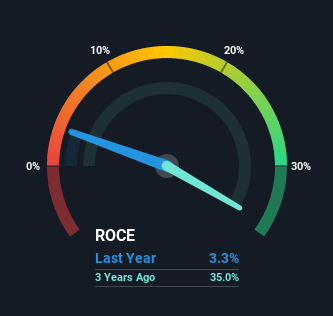Narnia (Hong Kong) Group (HKG:8607) Is Reinvesting At Lower Rates Of Return
If we want to find a potential multi-bagger, often there are underlying trends that can provide clues. Amongst other things, we'll want to see two things; firstly, a growing return on capital employed (ROCE) and secondly, an expansion in the company's amount of capital employed. Put simply, these types of businesses are compounding machines, meaning they are continually reinvesting their earnings at ever-higher rates of return. Although, when we looked at Narnia (Hong Kong) Group (HKG:8607), it didn't seem to tick all of these boxes.
Understanding Return On Capital Employed (ROCE)
Just to clarify if you're unsure, ROCE is a metric for evaluating how much pre-tax income (in percentage terms) a company earns on the capital invested in its business. To calculate this metric for Narnia (Hong Kong) Group, this is the formula:
Return on Capital Employed = Earnings Before Interest and Tax (EBIT) ÷ (Total Assets - Current Liabilities)
0.033 = CN¥6.3m ÷ (CN¥327m - CN¥135m) (Based on the trailing twelve months to September 2021).
So, Narnia (Hong Kong) Group has an ROCE of 3.3%. Ultimately, that's a low return and it under-performs the Luxury industry average of 7.0%.
Check out our latest analysis for Narnia (Hong Kong) Group

Historical performance is a great place to start when researching a stock so above you can see the gauge for Narnia (Hong Kong) Group's ROCE against it's prior returns. If you're interested in investigating Narnia (Hong Kong) Group's past further, check out this free graph of past earnings, revenue and cash flow.
How Are Returns Trending?
On the surface, the trend of ROCE at Narnia (Hong Kong) Group doesn't inspire confidence. Over the last four years, returns on capital have decreased to 3.3% from 28% four years ago. Although, given both revenue and the amount of assets employed in the business have increased, it could suggest the company is investing in growth, and the extra capital has led to a short-term reduction in ROCE. And if the increased capital generates additional returns, the business, and thus shareholders, will benefit in the long run.
On a side note, Narnia (Hong Kong) Group has done well to pay down its current liabilities to 41% of total assets. So we could link some of this to the decrease in ROCE. What's more, this can reduce some aspects of risk to the business because now the company's suppliers or short-term creditors are funding less of its operations. Some would claim this reduces the business' efficiency at generating ROCE since it is now funding more of the operations with its own money. Keep in mind 41% is still pretty high, so those risks are still somewhat prevalent.
In Conclusion...
In summary, despite lower returns in the short term, we're encouraged to see that Narnia (Hong Kong) Group is reinvesting for growth and has higher sales as a result. And there could be an opportunity here if other metrics look good too, because the stock has declined 68% in the last three years. As a result, we'd recommend researching this stock further to uncover what other fundamentals of the business can show us.
Narnia (Hong Kong) Group does come with some risks though, we found 5 warning signs in our investment analysis, and 2 of those shouldn't be ignored...
While Narnia (Hong Kong) Group may not currently earn the highest returns, we've compiled a list of companies that currently earn more than 25% return on equity. Check out this free list here.
Valuation is complex, but we're here to simplify it.
Discover if Narnia (Hong Kong) Group might be undervalued or overvalued with our detailed analysis, featuring fair value estimates, potential risks, dividends, insider trades, and its financial condition.
Access Free AnalysisHave feedback on this article? Concerned about the content? Get in touch with us directly. Alternatively, email editorial-team (at) simplywallst.com.
This article by Simply Wall St is general in nature. We provide commentary based on historical data and analyst forecasts only using an unbiased methodology and our articles are not intended to be financial advice. It does not constitute a recommendation to buy or sell any stock, and does not take account of your objectives, or your financial situation. We aim to bring you long-term focused analysis driven by fundamental data. Note that our analysis may not factor in the latest price-sensitive company announcements or qualitative material. Simply Wall St has no position in any stocks mentioned.
About SEHK:8607
Narnia (Hong Kong) Group
An investment holding company, manufactures and sells fabrics in Mainland China, Hong Kong, the United Arab Emirates, Egypt, Brazil, and internationally.
Mediocre balance sheet and slightly overvalued.
Market Insights
Community Narratives




